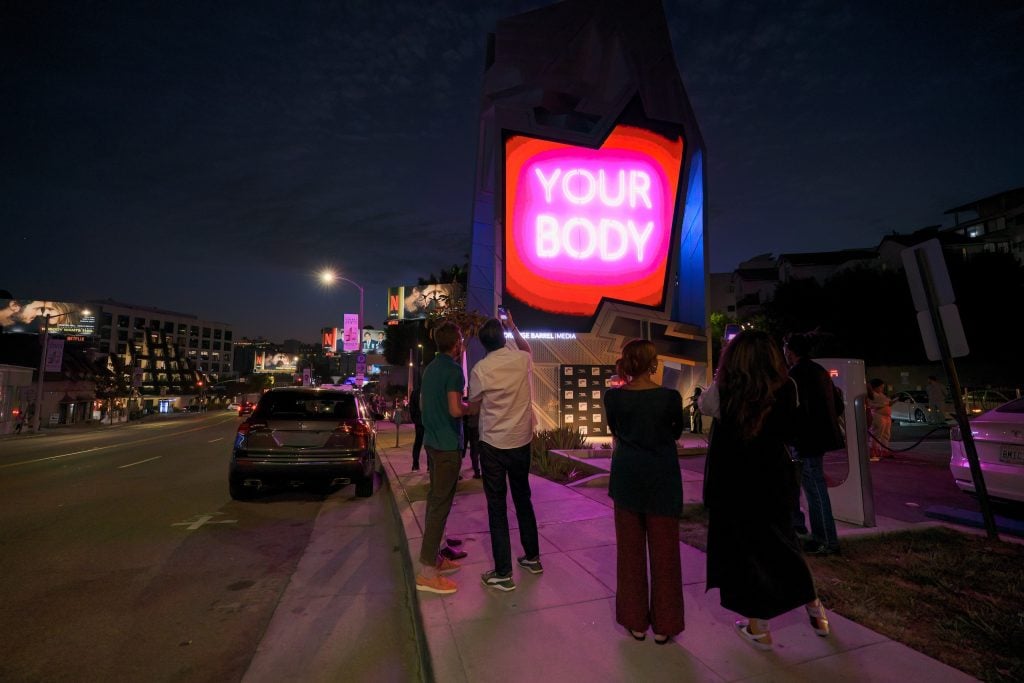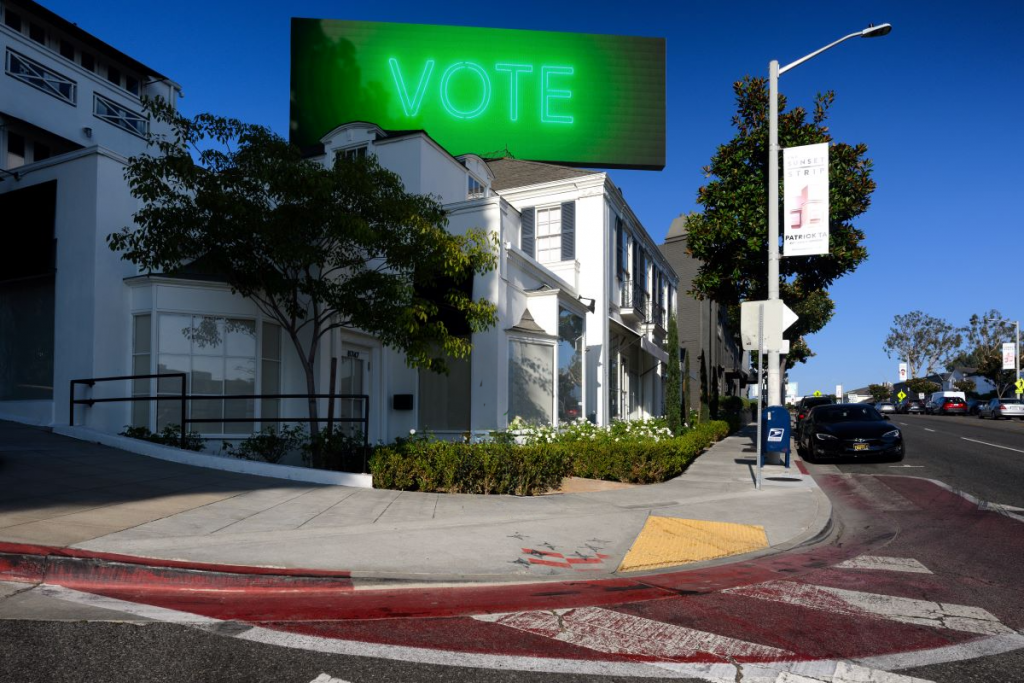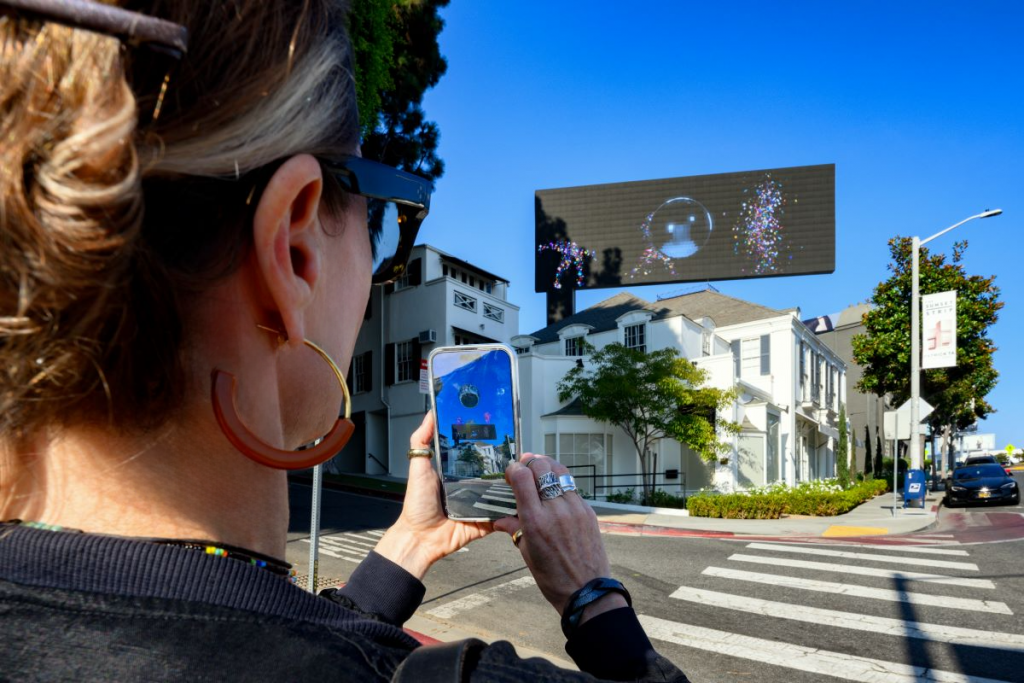Law & Politics
Artist Nancy Baker Cahill’s Billboard Project About Being Silenced Was Censored
The project is part of West Hollywood's Moving Image Media Art initiative.

The project is part of West Hollywood's Moving Image Media Art initiative.

Sarah Cascone

A Republican donor has censored a city-commissioned art project, briefly refusing to show Nancy Baker Cahill’s Body Politic on his billboard at the Sunset Place Building in West Hollywood.
The piece is a 10-minute, 30-second digitally animated artwork commissioned by West Hollywood’s Moving Image Media Art (MIMA) exhibition series as part of the city’s get-out-the-vote initiative. It first went on view October 1—but only on two of three planned billboards.
Cahill decried the censorship of the work in an Instagram post, saying, “This work, which is about the dangers of being silenced, is being silenced.”
The piece starts with pink neon text reading “Your Body” and ends with a call to vote.
“The film is really focused on reproductive justice, data privacy, and voting,” Cahill told me. It ends with a series of news headlines, shown in increasingly rapid succession, related to those and other pressing political issues.
“We have been reviewing the content internally, and in general we have a company policy to not run any political content,” Jason Cox, the CTO of digital billboard company Big Outdoor, wrote in an email to West Hollywood public art employees, which I reviewed. “Upon receiving this piece, we ran it by the property owner. They have respectfully asked us not to post this creative.”
The billboard is part of the Sunset Arts and Advertising Program, which allows billboard owners to convert traditional billboards into rotating digital displays. Each owner’s contract with the city stipulates that it is obliged to show MIMA artworks or other city content for 10 minutes and 30 seconds every hour—or 17.5 percent of the time.
According to the 2021 permitting request to convert the billboard in question, at 9157 Sunset Boulevard, the property owner is Bijan Chadorchi. Federal Election Commission records list him as a donor to the Make America Great Again PAC in 2020.
“He’s allowed to have whatever beliefs he wants, as we all are, but his billboard is a public platform for the arts,” Cahill said. ”It’s not his right to curate and dictate the content.”
This is the first time that the MIMA series, which launched in 2022, has had pushback about any of its artworks.
“The good news is that they’re going to play it today,” Rebecca Ehemann, West Hollywood’s public art program manager, told me.

Nancy Baker Cahill, Body Politic (2024) on a billboard on the Sunset Strip in Hollywood. Photo courtesy of the artist.
In response to an inquiry about why the billboard owner had violated the contract, and whether they were concerned about censorship in not showing it, a representative wrote back, saying only, “The billboard is now displaying Body Politic as requested by the City.”
The city had threatened legal action against the billboard operators, notifying them that they were in violation of the contract.
“We don’t tell them what to advertise. They don’t tell us what to play in our city content time,” Ehemann said, adding that it was “no surprise” that the billboard operators had come around.
“This is an amazing piece,” Ehemann added. “It will encourage people to vote and really [help them] understand what’s at stake with not just this election, but every election. It aligns with our city’s values, so we felt really great about bringing this to our community.”

Nancy Baker Cahill, Body Politic (2024) on a billboard on the Sunset Strip in Hollywood. Photo courtesy of the artist.
MIMA has plans to expand from three billboards along the Sunset Strip to as many as 28.
“It’s going to be pretty remarkable,” Ehemann said.
The current installation of Body Politic is more than just a billboard, though. It’s Cahill’s latest work to use augmented reality, visible only via her custom 4th Wall app. But while pieces for the Whitney Museum of American Art in New York and the Desert X biennial in southern California’s Coachella Valley could only be experienced via your smartphone, here the app adds to the existing real-world display.

Nancy Baker Cahill, Body Politic (2024) on a billboard on the Sunset Strip in Hollywood, with the artist using her 4th Wall app to view the work’s augmented reality component. Photo courtesy of the artist
Cahill invites viewers to vote for which of 12 basic human rights they find most important, including the right to vote, to be treated equally under the law, to bodily autonomy, and to peaceful protest.
Though the A.R. piece is meant to be experienced in view of the billboard, app users can access it from anywhere. Votes have already come in from as far afield as Europe, with bodily autonomy the early leader.
In the film, a uterus behind bars explodes, representing the Supreme Court’s 2022 overturning of Roe v. Wade. (The artist used the same image in State Property, an A.R. work she installed above the Supreme Court in Washington, D.C., and state house buildings in Idaho, Texas, North Carolina, and Georgia.)
A human figure is seen inside a server room that is later revealed to be inside the U.S. Capitol Building, their data seemingly flying between computers as a warning about government surveillance and biometric data extraction.
Queer dancers made up of sparkling swirls of colored light shimmy around a disco ball, a symbol of resistance.
And there are tiny glowing orbs Cahill calls “seeds” that suggest newly fertilized embryos.
“It’s this pulsing living cellular entity that grows and grows and grows and ultimately threatens to break the billboard and explode,” Cahill said. ”I imagine that as a poetic, multivalent symbol for, obviously, the experience of of pregnancy, but also of a movement or a conviction that grows and grows… something that’s related to rights that are in peril.”
“Nancy Baker Cahill: Body Politic” is on view on the Sunset Strip, at 8775 Sunset Boulevard, 8743 Sunset Boulevard, and 9157 Sunset Boulevard, West Hollywood, California, through February 28, 2025.